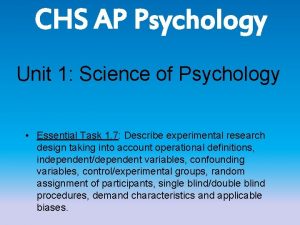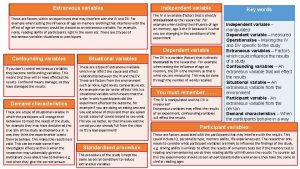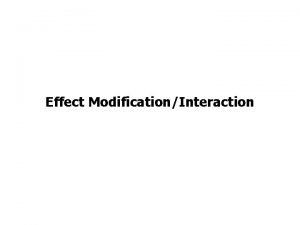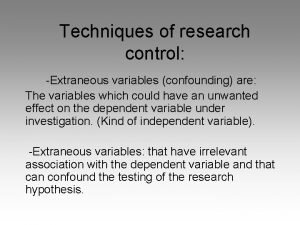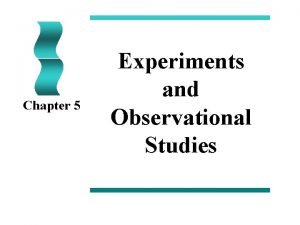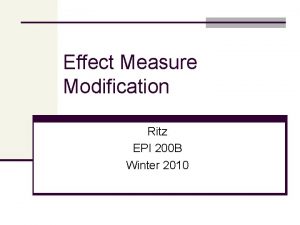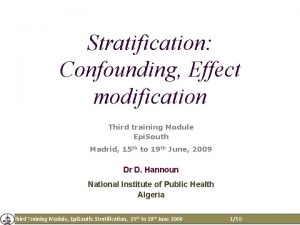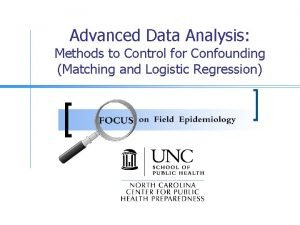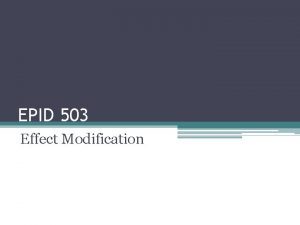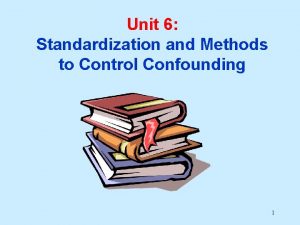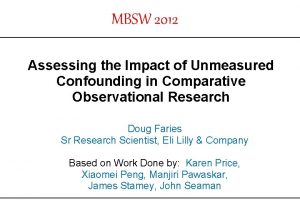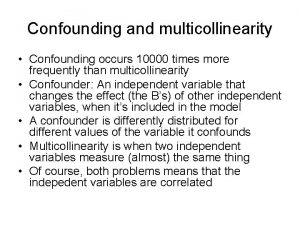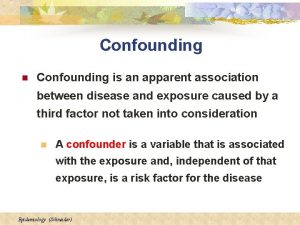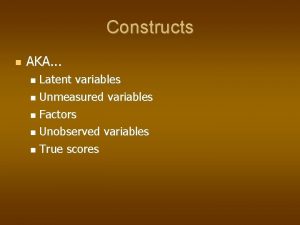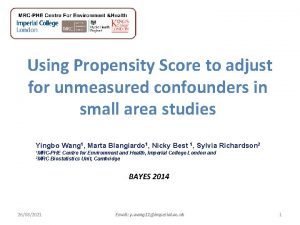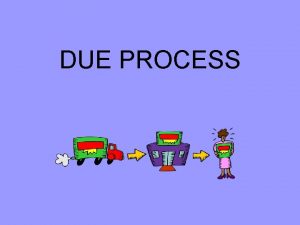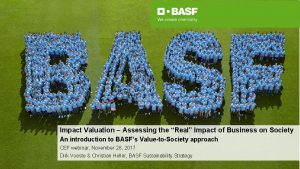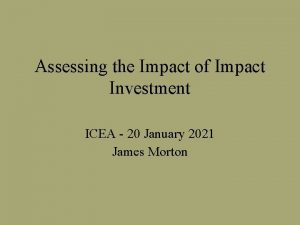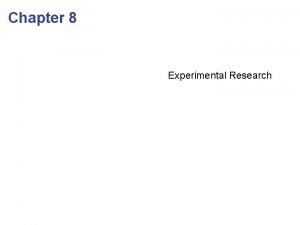Assessing the impact of unmeasured confounding due to




















- Slides: 20

Assessing the impact of unmeasured confounding due to selection bias in external comparator studies using RWD PSI Conference Webinar 2020 Session: Intersection of Clinical Trials and Real World Data Christen M. Gray 1, Michael O’Kelly 2, Fiona Grimson 1 IQVIA EMEA Data Science Hub IQVIA Center for Statistics in Drug Development, Decision Sciences © 2020. All rights reserved. IQVIA ® is a registered trademark of IQVIA Inc. in the United States, the European Union, and various other countries.

Questions to be answered today + What is an external comparator study and why would we use it? + What are the statistical challenges in performing an external comparator study? + Can we combine simpler analytical methods to successfully minimize selection bias in an external comparator study? If any of these things are not clear at or near the end, please ask more questions in the chat window! 1

External comparator studies make use of data external to the clinical trial Sources of external data: • • Real World Data (registries, electronic health records (EHR), chart review) Previous “historical” clinical trial See reference [1] 2

Trials face increasing challenges in enrolment while regulators are increasingly accepting of Big Data, leading to use of RWD external comparators Current challenges in clinical trials: • Trials in rare (‘orphan’) diseases and in vulnerable groups such as paediatrics • An increase in targeted medicines, applicable to smaller populations • And currently, difficulty in clinical trial enrolment during the Covid-19 outbreak External comparators can be used to increase the power of a clinical trial in the presence of enrolment restrictions Regulators have shown a willingness to consider evidence from RWD • The FDA has openly endorsed the use of external comparator studies drawing on RWD in specific circumstances [2] • An HMA/EMA Joint Big Data Taskforce made recommendations of the use of pooling clinical trial and RWD sources [3] • Several approvals have been made in orphan drugs by the FDA and EMA where external comparators where part of the evidence package, e. g. Blincyto, Zalmoxis [4, 5] 3

For an internally valid comparison, the two populations (trial and external) should be perfectly exchangeable with one another Exchangeability: if the treatment status were exchanged, on average, the value observed for the outcome in absence of the treatment would be the same [6]. For the minimum criteria for exchangeability [1, 7], these factors should be the same between populations: 1. Eligibility criteria 2. Patient characteristics/confounders 3. Mode of treatment Control group 4. Outcome measure 5. Time period 6. Setting Treatment group Where populations are not exchangeable, we have confounding 4

Analytical methods can be used to control for measured confounding Realistically, exchangeability will never be perfect without randomization. This is a challenge routinely encountered in observational data. Measured confounders can be addressed using covariate adjustment, propensity score (PS) methods, and causal inference methods Inverse probability weighting (IPW) can be used to balance the confounders between the populations with respect to the treatment by weighting the outcomes using propensity scores. Blincyto, a therapy for acute lymphoblastic lymphoma, was approved by the EMA using a supplemented single arm trial applying IPW to account for eight key confounders [4]. The major limitation of IPW, or any adjustment method, is that it can only balance measured confounders. The use of data gathered using a wholly different mechanism leads to the possibility of selection bias from unmeasured sources 5

A quick note on Bayesian statistics before we talk about Bayesian methods… A prior is a distribution summarizing prior knowledge or belief A non-informative prior is a distribution chosen to represent no prior knowledge A posterior is the distribution resulting from multiplying a likelihood given a model and data by a prior and normalising it over the probability of the data (which usually involves an intractable integral) MCMC (Markov chain Monte Carlo) is a group of algorithms for sampling probability distributions, as when there is an intractable integral. Samples can be used to infer attributes of the target probability distribution, in this case the posterior distribution Burn-in refers to the samples at the beginning of the MCMC process which may not represent the probability distribution because the algorithm has not yet found the area of highest probability Posterior mean is typically what is report as the effect estimate from a posterior distribution, sometimes the posterior median is used 95% Credible intervals are used to express the interval which contains 95% of the probability distribution and are used in lieu of confidence intervals 6

Bayesian dynamic borrowing methods can be used to combine outcomes from different sources, discounting external data Original power prior Empirical power prior The power prior is the product of an initial prior (non-informative prior) and the likelihood of a given model given the external data that is raised to a power between 0 and 1 (weighting parameter) [8]. The power prior is then applied to the internal control data. Relies on specifying a weighting parameter to capture how much one believes the external data should be discounted Also borrows dependent on the likeness of the data, but allows for the possibility that the external data is equal to the internal data (weight of 1) Modified, Normalised, or Commensurate power prior Various modifications of the power prior which do not require specification of a weighting parameter, borrows dependent upon the ‘likeness of the data’ Bayesian dynamic borrowing approaches Meta-analytic priors Hierarchical models may assume that each source of data is sampled from a larger population. The variability between sources is modelled as a random effect whose variance is to be estimated to create the meta-analytic prior 7

Fit-for-purpose software for Bayesian borrowing methods is limited General limitations of Bayesian borrowing • • • Software available (not complete) Choice of prior distribution can impact results, a poor choice can inflate type I error General purpose Bayesian software: • Win. BUGS Some understanding of Bayesian methods is required by both researcher and audience, including ‘burn-in’, posterior estimates, and credible intervals • JAGS • SAS PROC MCMC The methods can be performed using outcome distributions only or on full likelihoods including all data; however, for researchers with limited experience in Bayesian modelling, there is a reliance on availability of ‘packages’ or software which simplifies the methods, but most methods do not accommodate full likelihoods Fit-for-purpose R packages: • Study. Prior – implements power priors, empirical power priors, and meta-analytic priors using outcomes only • NPP – implements normalised power prior using outcomes only • RBes. T – implements meta-analytic priors 8

Biostatisticians may be reluctant to adopt Bayesian borrowing methods due to complexity A paper authored in 2017 by the paediatric sub-team of the FDAs Drug Information Association (DIA) Bayesian Scientific Working Group and Adaptive Design Working Group, identified the following barriers to uptake of Bayesian borrowing methods [9]: 1. The Bayesian approach may require an initial assessment of exchangeability 2. The lack of appropriate and user-friendly, robust software for Bayesian borrowing methods 3. Limited number of statisticians trained in Bayesian methods We propose using normalized Bayesian borrowing approaches available in packages in combination with IPW http: //www. bayesianscientific. org/wp-content/uploads/2016/11/Pediatric_BSWG_Aug 28_2016. pdf 9

We used the normalized power prior on outcome distributions only for its simplicity of implementation Normalized power prior method External data Uninformative prior distribution R package ‘NPP’: Normalised Power Prior Bayesian Analysis Posterior sampling in several common distributions using the normalized power prior [10, 11]. Sampling of the power parameter is achieved via Metropolis-Hastings (MCMC sampling). R function: Internal data Power prior Normalizing constant pp <- Normal. NPP_MCMC(Data. Cur = data$Y[data$trial==1 & pdata$Tx==0], Data. Hist = data$Y[data$trial==0], nsample=5000) We removed the first 1000 samples (‘burn-in’ of the MCMC sampling) Posterior distribution We then estimated the ‘posterior mean’ of the outcome across all control patients (both internal and external combined) from the remaining 4000 samples The treatment effect can be estimated. 10

Can propensity score methods be effectively combined with Bayesian dynamic borrowing methods to reduce bias? We propose: • 11

A note about the probability of being treated vs the probability of being in the trial When applying IPW-alone, we are treating all control patients the same – both trial and external controls are pooled. We then adjust for confounders relative to treatment so that the treatment is unconfounded. When using IPW to adjust outcome for use in NPP, we are adjusting for confounding relative to inclusion in the trial according to measured confounders in order to discount the external group only as much necessary to address unmeasured confounders. We performed IPW+NPP using the probability of treatment in our simulations study (not presented). It always performed slightly worse that using the probability of being in the trial, as expected. Trial/Control Trial/Treated P(Trial=1 & Tx=0) P(Trial=1 & Tx=1) External Control P(Trial=1 & Tx=0) 12

The simulation study was designed to mimic trial vs RWD and to test three levels of unknown confounding Simulation study objectives: 1. To simulate a continuous outcome, such as a laboratory measure, in an oncology study 2. To simulate a small set of confounders with a different distribution in the trial vs RWD including age, sex, and occupational exposure to hazardous substances; we assumed: - Trial patients are younger (healthier) - Trial patients are more likely to be female - Trial patients are more likely to have occupational exposure - The risk of occupational exposure in RWD patients increases with age 3. To simulate an unmeasured confounder that also has some covariance with the other observed variables; this will result in: - The observed covariates contain some information about the unknown confounder - Differential distributions of the observed confounders between the trial and the external data will result in selection bias 13

The simulation study was designed to mimic trial vs RWD and to test three levels of unmeasured confounding Simulation study design, 100 repetitions per scenario: Variable Sample size Symbol N Trial Value RWD Value 500, 5: 1 treated: control 1000 Age Zage N(μ=45, σ=8) N(μ=60, σ=8) Sex (female) Zsex Be(P=0. 6) Be(P=0. 5) Occupational exposure Zchem Be(P=0. 6) Be(P=0. 2+(Zage/500)) Unmeasured confounding U N(μ=10+(40+(Zage/200))*1. 5*Zchem, σ=5+(Zsex*0. 9)) Outcome Y N(μ=0. 05*Zage+-0. 2*Zsex+2. 8*Zchem+-2. 0*Tx+ZU*U, σ=1) Three unmeasured confounding scenarios: None, Weak, Strong None: ZU= 0 Weak: ZU = 0. 5, confounder ¼ the effect of treatment Strong: ZU = 2. 0, confounding equal to the effect of treatment 14

The simulation study compared the use of each independent method to the use of the combined method Applied four methods to the simulated data For each set of 100 simulations, we found the average bias of the estimated treatment effect and as well as the standard deviation of the bias of the treatment effect across simulations. Method 0: No adjustment Fit the whole data set, trial and internal, to a simple linear regression where treatment was the only covariate. Method 2: NPP-only Performed NPP to combine outcomes in the external data and internal control as previously described. Estimated the treatment effect as the difference between the posterior mean of the control and the observed mean of the treated. Method 1: IPW-only Use of classic IPW, weighting in the outcome regression model based on the probability of being treated, before fitting a simple linear regression where treatment was the only covariate. Method 3: IPW+NPP Predict adjusted outcomes by weighting control patients on the probability of being in the trial, before applying NPP to combine the control outcomes and estimating the treatment effect. 15

Use of NPP leads to a significant reduction in bias with further reduction achieved by combining NPP with IPW Results of simulation study: Bias in the Treatment Effect (SD) Method No unmeasured confounding Weak unmeasured confounder Strong unmeasured confounder 0: No adjustment 0. 008 (0. 071) -5. 917 (0. 605) -23. 806 (2. 252) 1: IPW-only 0. 003 (0. 089) -4. 811 (0. 654) -19. 565 (2. 327) 2: NPP-only -0. 109 (0. 206) -0. 946 (1. 833) -3. 688 (6. 971) 3: IPW+NPP -0. 077 (0. 198) -0. 791 (1. 809) -3. 102 (6. 849) The outcome mean value was approx. 3 in simulations with an SD of approx. 1. 8 • • IPW performs best in the absence of any unmeasured confounding, as expected NPP corrects most of the bias, but has greater variability in the bias because the resulting effective sample size is smaller The combination of IPW and NPP shows the greatest reduction in bias in the presence of unmeasured confounding The combination of IPW and NPP has slightly more bias and greater variability in the bias when no unmeasured confounding is present likely due to a smaller effective sample size, as with NPP alone 16

Further work In our changing world, large RCT trials are increasingly infeasible for some therapeutic areas. Patient advocates increasingly call for faster means of getting novel therapies to hospitals, especially in cases of severe and rare disease. In many cases the value of equipoise must be balanced against the need for randomization, particularly for vulnerable groups like children. Further simulation studies Demonstration in RWD Quantitative bias analysis 1 2 3 In this work, we explored one combination of simple methods. Larger simulation studies of the breadth of methods would help direct researchers. As a start, we intend to extend this work to compare against an implementation in JAGS using the full likelihood of the data. Demonstrations in real data are needed to show whether the methods are robust to the surprises and complexity of real world data Quantitative bias analysis is set of methods for estimating the impact of bias given reasonable assumptions. It can be a powerful tool for estimating the effect of known sources of unmeasured confounding. Further work should be done to assess how this methodology can be used in combination with Bayesian dynamic borrowing methods 17

References 1. Gray, C. M. , Grimson, F. , Layton, D. , Pocock, S. , & Kim, J. (2020). A Framework for Methodological Choice and Evidence Assessment for Studies Using External Comparators from Real-World Data. Drug Safety. 2. Gottlieb S. Statement from FDA Commissioner Scott Gottlieb, M. D. , on FDA’s new strategic framework to advance use of realworld evidence to support development of drugs and biologics. FDA Press Release. December 2018. https: //www. fda. gov/news-events/press-announcements/statement-fda-commissioner-scott-gottlieb-md-fdas-new-strategicframework-advance-use-real-world Accessed April 21 2020. 3. Head of Medicines Agency and European Medicines Agency. HMA-EMA Joint Big Data Taskforce – Summary Report. 2019. https: //www. ema. europa. eu/en/documents/minutes/hma/ema-joint-task-force-big-data-summary-report_en. pdf Accessed April 21 2020. 4. European Medicines Agency. Assessment Report of BLINCYTO EMA/CHMP/469312/2015. https: //www. ema. europa. eu/en/documents/assessment-report/blincyto-epar-public-assessment-report_en. pdf Accessed April 21 2020. 5. Committee for Medicinal Products for Human Use. Assessment Report of Zalmoxis EMA/CHMP/589978/2016. https: //www. ema. europa. eu/en/documents/assessment-report/zalmoxis-epar-public-assessment-report_en. pdf Accessed April 21 2020. 6. Greenland S and Robins J. Identifiability, exchangeability, and epidemiological confounding. Int Jrnl Epi. 1986; 15(3): 413 -419. 7. Pocock S. The combination of randomized and historical controls in clinical trials. J chronic Dis. 1976; 29: 175 -188. 8. Ibrahim JG, Chen M-H. Power prior distributions for regression models. Stat Sci. 2000; 15(1): 46 -60. 9. Gamalo‐Siebers, M. , Savic, J. , Basu, C. , Zhao, X. , Gopalakrishnan, M. , Gao, A. , . . . & Price, K. (2017). Statistical modeling for Bayesian extrapolation of adult clinical trial information in pediatric drug evaluation. Pharmaceutical statistics, 16(4), 232 -249. 10. Duan, Y. , Ye, K. , & Smith, E. P. (2006). Evaluating water quality using power priors to incorporate historical information. Environmetrics: The Official Journal of the International Environmetrics Society, 17(1), 95 -106. 11. Ibrahim, J. G. , Chen, M. H. , Gwon, Y. , & Chen, F. (2015). The power prior: theory and applications. Statistics in medicine, 34(28), 3724 -3749. 18

Questions? For further inquiries, email christen. gray@iqvia. com 19
 Unmeasured anions
Unmeasured anions Confounding variables psychology
Confounding variables psychology Extraneous variables
Extraneous variables Effect modification vs confounding
Effect modification vs confounding What is extraneous variables
What is extraneous variables Confounding variable
Confounding variable Strongest research design
Strongest research design Effect modification vs confounding
Effect modification vs confounding Effect modification vs confounding
Effect modification vs confounding Obscuring factors
Obscuring factors Examples of confounders
Examples of confounders Why control for confounding variables
Why control for confounding variables Effect modification epidemiology
Effect modification epidemiology Effect modifier vs confounder
Effect modifier vs confounder Chance bias and confounding
Chance bias and confounding Confounding vs effect modification
Confounding vs effect modification How to control for confounding
How to control for confounding Quadrilateri con due lati paralleli
Quadrilateri con due lati paralleli Liberty chapter 20
Liberty chapter 20 Pentacosiomedimni cavalieri zeugiti teti
Pentacosiomedimni cavalieri zeugiti teti Conservazione del moto
Conservazione del moto

